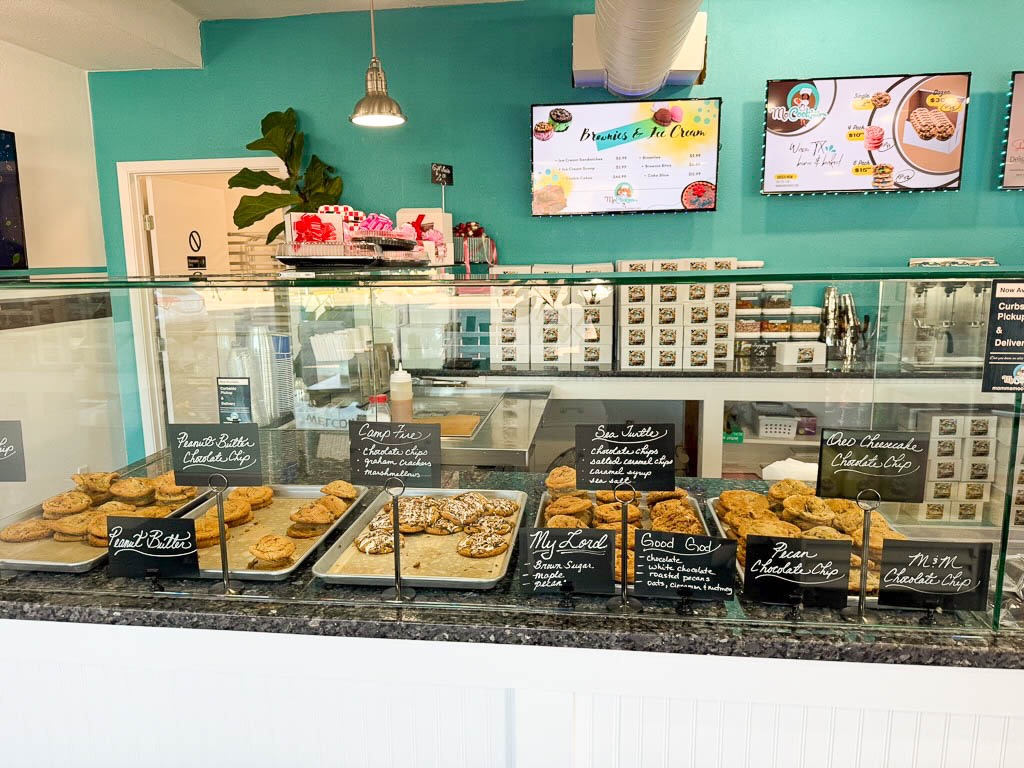Baylor University’s campus looks a little different at the moment. There are fenced-off portions of campus undergoing obvious reconstruction, accompanied by the sights of orange cones and the shouts of crew workers. A major project at the heart of campus that is causing much of this congestion is a huge step towards Baylor’s future.
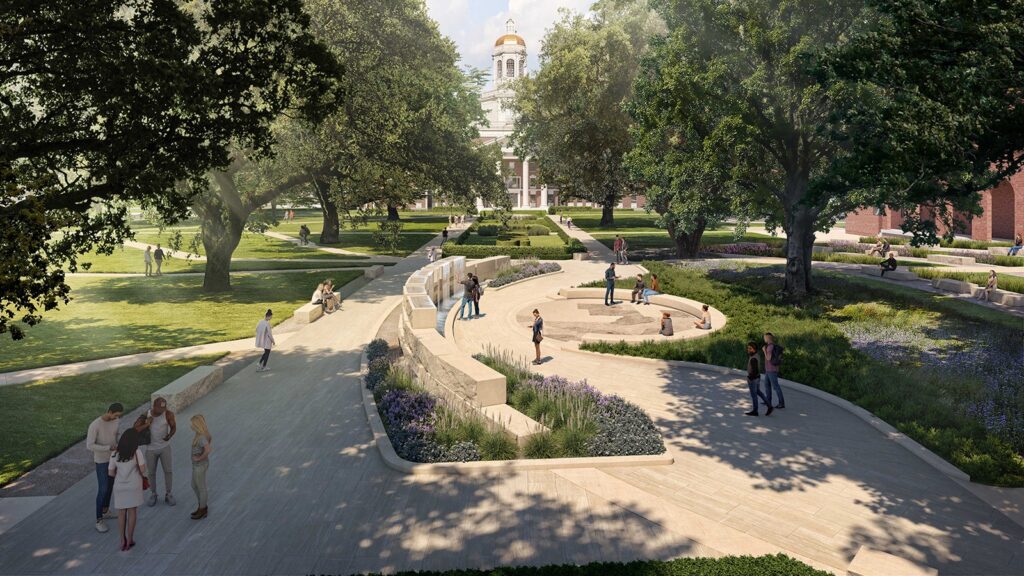
The Memorial to Enslaved Persons is restructuring Founders Mall to acknowledge the immoral use of chattel enslavement during the building of Baylor’s original campus in Independence and the activities of daily life for nearly two decades. On Baylor’s ‘Background & History for a Memorial to Enslaved Persons’ webpage, it states, “It is an acknowledgment of a challenging part of our history while helping us see the need for Christian repentance while we press toward renewal, reconciliation and restoration.” Unfortunately, this isn’t the only accountability Baylor needs to take.

Previously, Baylor University and the City of Waco attempted to reconcile with Indigenous populations that originally inhabited the area. In October of 2020, Baylor authorized research on the history of Baylor’s land and its connections to Indigenous People, and in November of 2022, the University presented a Land Acknowledgement during Native American Heritage Month. In May of 2022, the Baylor Board approved a four-phase plan to address priorities identified by the Commission on Historic Campus Representations:
Phase One is complete, with the new Campus Experience Project.
Phase Two formally began February 20, 2024, with the ceremonial groundbreaking for the Memorial to Enslaved Persons. This phase also includes additional historical context being placed around the existing Judge Baylor statue, connecting his history of enslavement with those individuals recognized by the Memorial.
Phase Three will include enhancements to Speight Avenue that explain how the land upon which Baylor sits evolved and was developed, often at the expense of communities and individuals already occupying the property.
Phase Four will feature improvements along the Quadrangle.

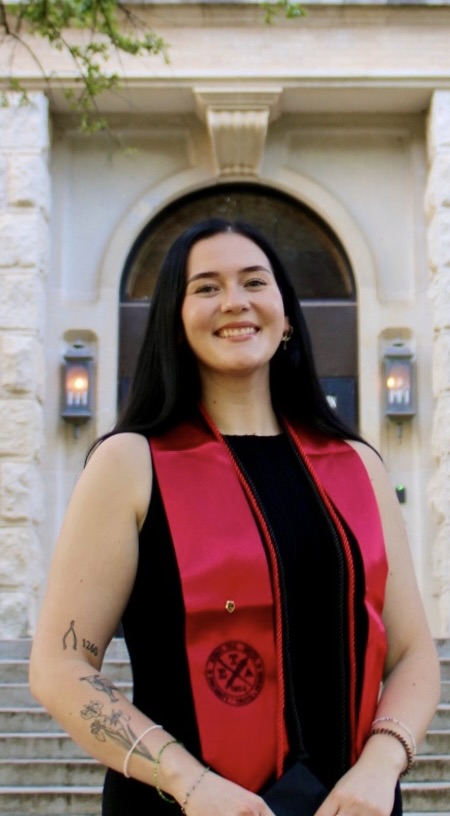
Elizabeth Riley hails from Tennessee and is a graduate of English Literature and Professional Writing & Rhetoric from Baylor University. With passions in archival preservation, communal connection, and women in sports, she writes because it matters, with hopes of bridging villages and fostering revelry amongst them.
A Celebration of Heritage and Diversity
by: Debrah Wright
Black History Month serves as an annual tribute to the remarkable achievements of African Americans, highlighting their pivotal role in shaping the nation’s history. In Waco, Texas, we proudly participate in this celebration, fostering a sense of community and understanding through a diverse array of events throughout the month.
Originating from “Negro History Week,” conceived by historian Carter G. Woodson and other influential African Americans, Black History Month gained official recognition in 1976, with every U.S. president designating February as a time to honor the contributions of African Americans.
Waco’s rich history is deeply intertwined with the presence and influence of African Americans, dating back to the mid-nineteenth century when the first black residents, initially brought as slaves, played pivotal roles in the region’s development. Post-Civil War, they actively worked to rebuild their lives as freedmen and freedwomen, contributing significantly to the growth of Waco and McLennan County.
From the historic HBCU Paul Quinn College to the Farmers Improvement Society advocating for equal treatment post-Civil War, Waco’s Black history is filled with inspiring narratives. All Waco residents and visitors alike can celebrate Black History Month by exploring Black-owned businesses and participating in various events and learning opportunities throughout February.
Highlighted events include a Ceremonial Groundbreaking for the Memorial to Enslaved Persons hosted by Baylor University on February 23 at 1:30 P.M. and a Black History Walking Tour led by experts from Baylor University’s Institute for Oral History on Saturday, February 24th.
Join experts from Baylor University’s Institute for Oral History as they lead you through Downtown Waco for its third annual Black History Walk. Gain insights into historic locations during this educated tour, where guides will highlight influential Black figures like Waco’s first Black mayor, the initial Black female mayor, and the late Commissioner Patricia Miller.
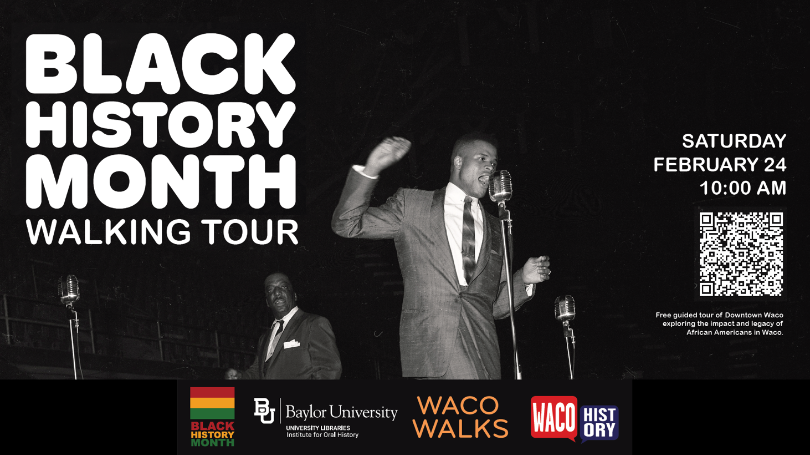
Notably, Waco’s Black history once thrived on Bridge Street, but after the 1953 tornado, business owners relocated to Elm Avenue. The walk commences at the McLennan County Courthouse in downtown on Saturday, February 24th, running from 10 a.m. to 12 p.m. Be part of this enriching journey uncovering the impactful stories woven into Waco’s historical tapestry.
Waco residents and visitors can also embark on a self-guided tour of Black history throughout the city, curated by Baylor’s Institute for Oral Histories and the Texas Collection. This tour, running from February 1 to 29, explores significant landmarks, churches, bridges, and businesses that contribute to Waco’s diverse heritage.
Additional events include “Black History in the Archives” on February 27th at 4 p.m., hosted by the Black Faculty & Staff Association and The Texas Collection at the Carroll Library, and an Afro-LatinX Cultural Heritage Celebration on February 28th, hosted by the Society for Advancement of Chicanos/Hispanics and Native Americans in Science at Baylor University in the Student Union Building at 5 p.m. There is also the Big XII Conference on Black Student Government, hosted by Iowa State University from February 29 to March 3, promises a series of engaging discussions and activities.
Explore the Mini Black History Museum at the Dewey Community Center before it closes on February 29th. The Dewey team has curated an excellent display, and the exhibit is available during the following hours:
Monday to Thursday: 9 a.m. to 9 p.m. (museum closed from 3 p.m. to 6 p.m.)
Friday: 9 a.m. to 3 p.m. (museum closed after 3 p.m.)
Saturday: 9 a.m. to 3 p.m.
Don’t miss the chance to immerse yourself in this enlightening experience celebrating Black history.
Furthermore, Creative Arts Experiences held throughout the month provide opportunities to delve into the works of influential Black authors, musicians, and theatrical performances.
Experience the enchanting melodies of America’s most original genre, jazz, with Baylor’s Concert Jazz Ensemble on February 29 at 7:30 p.m. in Jones Concert Hall, Glennis McCrary Music Building.
Join us in Waco as we commemorate Black History Month, embracing the past, present, and future of our diverse community.
By Mary Beth Farrell
November marks the one-year anniversary of the opening of the “Sit Down to Take a Stand” Waco lunch counter exhibit at the Dr Pepper Museum. The lessons learned in the process of creating this exhibit and living with its impact have shaped the staff and board in ways we could not have anticipated.

Thank you to our exhibit committee members – Dexter Hall, Anthony Betters Sr., Gary Myles, Dr. Stephen Sloan, and Joy Summar-Smith – for leading us to a better understanding of the influence our Soda Fountain could have on visitors.
Over 2.7 million visitors have come to the museum since we opened in 1991, and the Soda Fountain – the original home of the Dr Pepper float – has been a favorite part of the experience for so many. However, before the civil rights movement, people of color were denied service at locations throughout Waco, including local soda fountains.
In the reexamination of our exhibits and the stories they tell, we realized the nostalgia surrounding soda fountains that people found in our space was not substantive enough to carry us through the next 31 years. The result of this reflection is “Sit Down to Take a Stand,” a recreated lunch counter that features audio from local sit-in participants, video from sit-ins in Houston, and photographs from across the South creating a moving, immersive experience for museum visitors.
The exhibit is in the Soda Fountain so all visitors can access it without paying admission. The Soda
Fountain was also redesigned with a 1960s theme to reflect a time when all patrons were welcome while keeping the vintage feel visitors expect.
“Sit Down to Take a Stand” is only the beginning. In February 2023, the most iconic space in the Museum – the historic Bottling Room – will reopen to the public featuring the stories of the workers who operated the bottling plant. Unfortunately, this exhibit hasn’t been updated since the museum opened in 1991 and currently tells the story of nostalgia from the perspective of those running the company, largely leaving out the contributions of everyday workers.
If you have never visited the museum or it’s been a while since you’ve stopped by, now is the time! In addition to telling the stories of Dr Pepper and the soft drink industry in a way we have never done before, the experiences the museum has to offer are one-of-a-kind. Make-A-Soda, Taste-A-Soda, the Extreme Pepper Experience, and the Paranormal Experience take your visit to the next level.
To support the historic Bottling Room renovation, visit our website and donate to our annual Challenge Grant. Our Challenge Grant goes to the preservation of our historic buildings and our collection. With every dollar donated, Keurig Dr Pepper will match the donations up to $100,000.
Mary Beth Farrell is director of development & communications for the Dr Pepper Museum.
By Deneece Ferrales
Feb. 7 is National Black HIV/AIDS Awareness Day. Uriah Robertson and the team at Waco-McLennan Public Health District who work in the clinic for HIV/AIDS services are preparing to use the occasion to raise HIV/AIDS awareness and encourage testing.“

Studies show that African Americans make up about 45 or 47 percent of new HIV diagnoses,” Robertson said. “Amongst women, we are seeing that African American women are 57 percent of new diagnoses. So, how do we decrease the numbers? We have to educate, advocate, encourage routine testing and so much more.”
As a risk reduction specialist, Robertson said his job is to “work with the community to provide intervention and prevention tools. We even perform HIV testing and encourage the importance of knowing your status.” Risk reduction specialists “have those conversations that others are afraid to have. We work to build rapport with our clients so we can get out into the clinic so that we can get the word out about our services while also working to break down the walls of stigma about HIV/AIDS.”
According to HIV.gov, a website managed by the U.S. Department of Health and Human Services, he first Black HIV/AIDS Awareness Day was held in 1999 as a grassroots opportunity to raise awareness in minority communities. In 2001, the day was given national status. This became needed as the number of new infections were disproportionately affecting people of color, particularly Black communities. At that point, new cases of HIV were escalating so quickly in the Black community that national leaders and the Centers for Disease Control began concerted efforts to combat the spread of HIV/AIDS in communities of color. According to the CDC, the history of these efforts includes:
- In 1998, the Congressional Black Caucus joined African American leaders from all over the U.S. to declare a “state of emergency” and created the Minority AIDS Initiative to offer funding for prevention efforts in Black communities. The CDC launched an array of prevention efforts aimed at preventing the spread of HIV among African Americans as a result of this funding.
- In 2000, HIV cases among Black and Latino men exceeded cases among White men, which was disproportionate to the general population, thus calling attention to health inequities surrounding the spread of HIV/AIDS.
- In 2007, the CDC launched its expanded HIV testing initiative to increase testing opportunities, primarily among African Americans.
- In 2008, the Black AIDS Institute reported that if Black America were its own country, it would rank 16th in the world in terms of number of people with HIV. It was estimated that 1 in 16 Black men would contract HIV/AIDS in their lifetime (approximately 6% of the population) and 1 in 32 Black women would contract HIV/AIDS in their lifetime.
- In 2010, the Obama Administration released first National HIV/AIDS strategy for the United States, which called on the nation to focus HIV prevention efforts on those at greatest risk, including African Americans.
Despite these efforts, sadly, this has not changed in the past 23 years. African Americans, more than any other race, have the highest rates of HIV infection in the nation. Black Americans account for approximately 14% of the U.S. population, but nearly half of those living and dying with HIV and AIDS are Black. Within this population, gay and bisexual men are the most affected, followed by heterosexual women. AIDS is the third leading cause of death among Black women aged 25–34 and 35– 44 and among Black men aged 35–44 (CDC).
Not only does this health inequity appear in the number of African Americans contracting HIV/AIDS, it also appears in the treatment of HIV/AIDS. Compared to all other persons with HIV, African Americans had the lowest rates of viral suppression. According to the CDC, out of every 100 Black persons living with HIV, only 63 are receiving some type of HIV care, 48 of 100 were retained in HIV care, and 51 of 100 were virally suppressed. This means that little more than half of all African Americans living with HIV received any type of treatment.
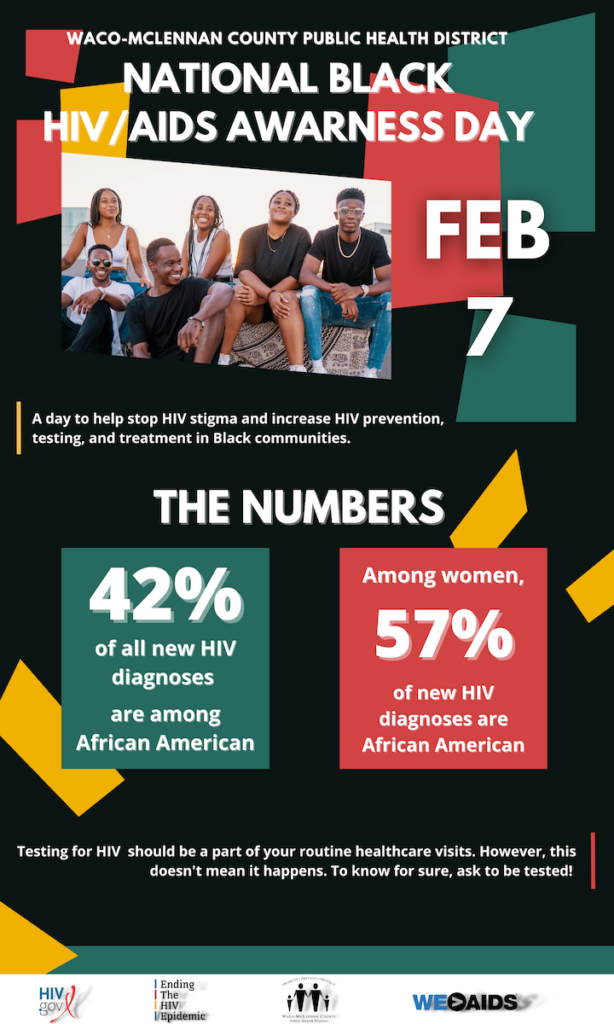
Though HIV is preventable, prevention remains the biggest challenge and further calls attention to the health inequities around this disease in Black communities. The challenges to prevention efforts include the stigma of a positive HIV status, people not having awareness of their HIV status, homophobia, racism, and mistrust of the healthcare system.
Lack of awareness of one’s HIV status can also lead to poor HIV treatment outcomes. Further, STI rates among African Americans are higher than among any other minority group, and there is a link between being diagnosed with other Sexually Transmitted Infections (STIs) and contracting HIV.
Lastly, persons experiencing poverty, which is higher in Black communities, are less likely to have access to quality healthcare for HIV, stable housing, and HIV prevention services.
So where do we start in addressing this health inequity? The most important place to begin is to encourage testing. If HIV is left untreated, chronic illness and death are the likely outcomes.
The first step to preventing this is for a person to know his or her status. Knowing one’s status can also prevent the further spread of HIV. Health professionals must continue to partner with Black community leaders to make outreach efforts aimed at more testing and increased awareness of prevention.
HIV treatment and prevention has come a long way in the past three decades. On Feb. 7, it is important to increase awareness of the continued need to address HIV prevention and treatment, particularly in Black communities. This is also a great day to encourage testing and the importance of knowing your status. Together, we can continue that fight to eradicate HIV/AIDS.

Deneece Ferrales, Ph.D., is director of health initiatives for Prosper Waco.
The Act Locally Waco blog publishes posts with a connection to these aspirations for Waco. If you are interested in writing for the Act Locally Waco Blog, please email the ALW team — [email protected].
The Waco-McLennan County Public Health District has partnered with area African American churches, the Waco NAACP, and VOICE to host a second “Shots for Souls” COVID-19 Vaccination Drive 1-4 p.m. Sunday, Nov. 14, at the Health District, 225 W. Waco Dr.
Participants can choose from the Pfizer, Moderna, or Johnson & Johnson vaccines. Adult vaccines, including boosters, and vaccines for children 5 years of age and older will be available. Lunch for the first 200 participants will be provided by the NAACP. Walk-ins are welcome and registration can be done on-line at covidwaco.com or at 254-750-5460.
“The holidays are fast approaching, and the health district is working with several organizations to get vaccines distributed just in time for the holidays,” said LaShonda Malrey-Horne, director of the health district. “The health district is collaborating with Waco NAACP, local Black churches, and VOICE Waco to offer vaccines to the East Waco community so families can enjoy the holiday season safely this year.”
Vaccination is the most effective way to slow the spread of disease and significantly decrease hospitalizations and fatalities due to COVID-19.
By Dexter Hall
During my many readings about financial security and understanding how we arrived at this point in time, I have run across many articles and commentary.
An article by Rocio Sanchez-Moyano and Bina Shrimali, of the Federal Reserve Bank, sheds light on how years of financial exclusion of Black and Brown communities have led to many of our present-day problems and issues. The article, titled “The Racialized Roots of Financial Exclusion,” reveals the fact that access alone is not enough.
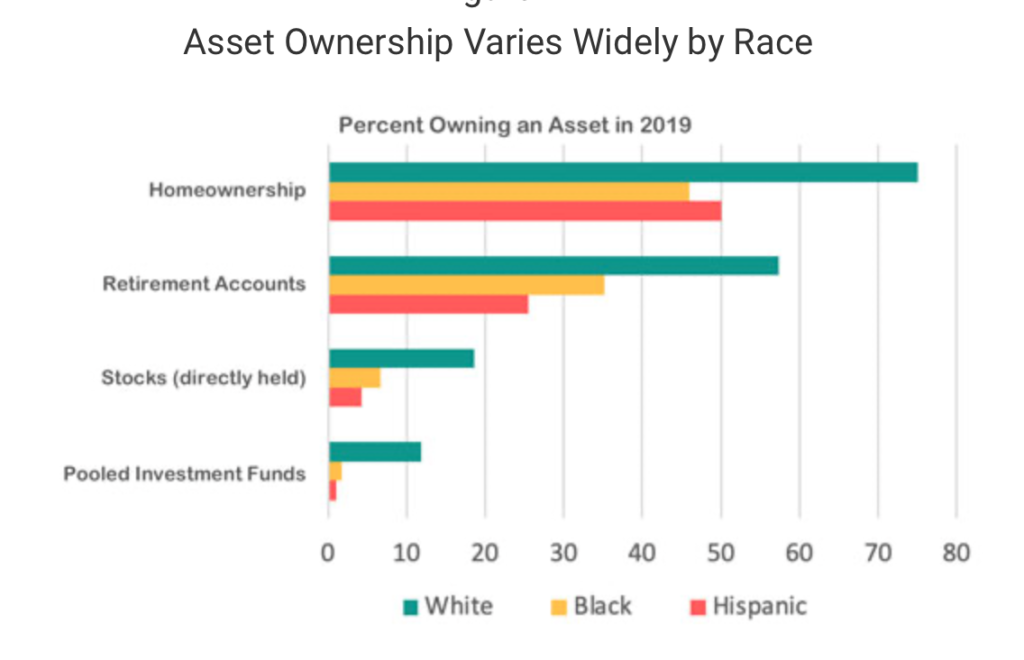
We often share information about redlining and racially restrictive housing covenants that were the law of the land in cities across America that barred “negroes” from buying in areas that were deemed “white” only.
Rocio and Bina share an example from a 1950 covenant on a property in Daly City, Calif. The covenant said: “The real property above described, or any portion thereof, shall never by occupied, used or resided on by any person not of the white or Caucasian race, except in the capacity of a servant or domestic employed thereon as such by a white Caucasian owner, tenant, or occupant” (cited from Richard Rothstein’s The Color of Law: A Forgotten History of How Our Government Segregated America, p. 78‒79).
Rothstein also cited a practice called blockbusting, which “refers to the practice of telling white homeowners that Black people are moving to induce concern about forthcoming declines in property values, which sometimes led to sales at a loss that were then sold to Black people at a profit” (Rothstein, p. 95).
The Rocio and Bina article discusses in extremely clear terms how the Black-White wealth gap came to be. More importantly, the authors help us understand why there is a need for direct investment in communities of color to balance the scale that was tipped purposely and intentionally.
Understanding the intersectionality of financial security to health and educational outcomes continues to be a bedrock of creating a more thriving community for all Wacoans. This is our challenge together in creating an inclusive economy for all.
In straightforward terms, when all people win, we all win. However, when one of our brothers and sisters loses or is left behind, we all lose.
The data we previously shared from the 1934 redlining map shows us where we should expect issues and problems today in Waco because of intentional non-investment in the past. The data today, 87 years later, show large amounts of poverty persist in East Waco and parts of South and North Waco. In other words, today’s poverty map mirrors the 1934 redlining map.
Implementing the City of Waco’s Financial Empowerment Blueprint is needed now more than ever. Let’s act today to change the future of Waco.
For more information on how to get involved in [email protected]. The time is now.
Please look at the full article by Rocio and Bina, as well as the documented research included in their endnotes.
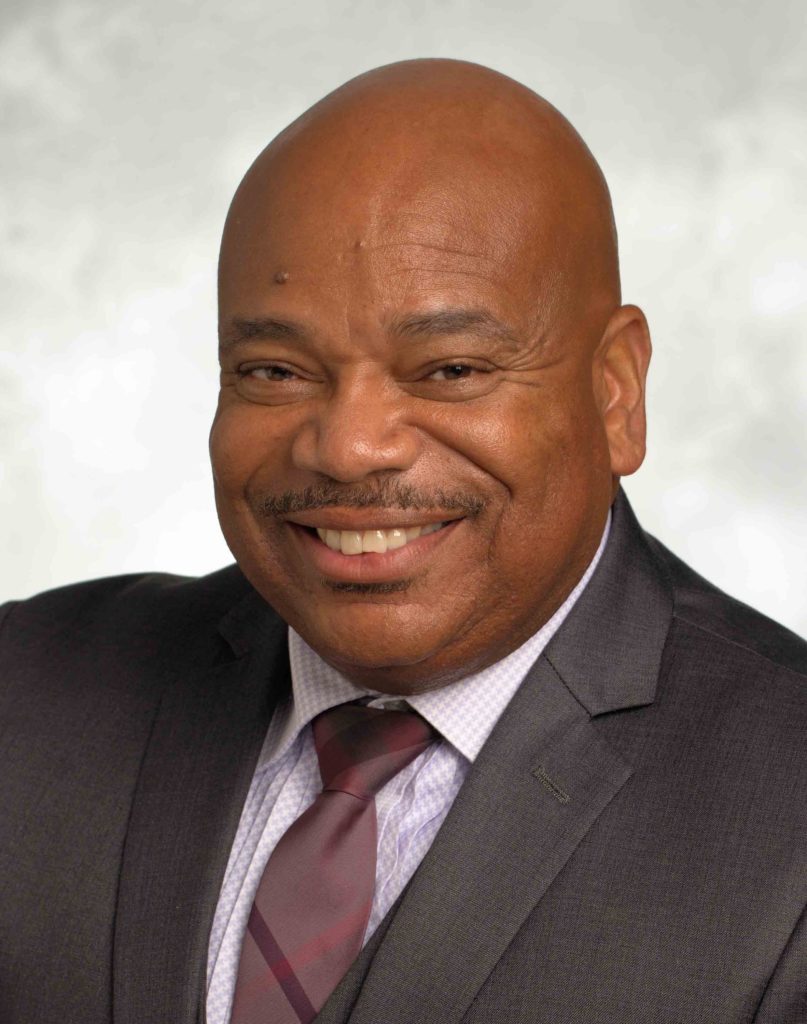
Dexter Hall is chief of staff and senior specialist for financial security with Prosper Waco.
The Act Locally Waco blog publishes posts with a connection to these aspirations for Waco. If you are interested in writing for the Act Locally Waco Blog, please email Ferrell Foster at [email protected].
By Baylor School of Education
Baylor University has named Lakia Scott the school’s “Champion of Change” this year. Dr. Scott is an associate professor in Baylor’s School of Education.
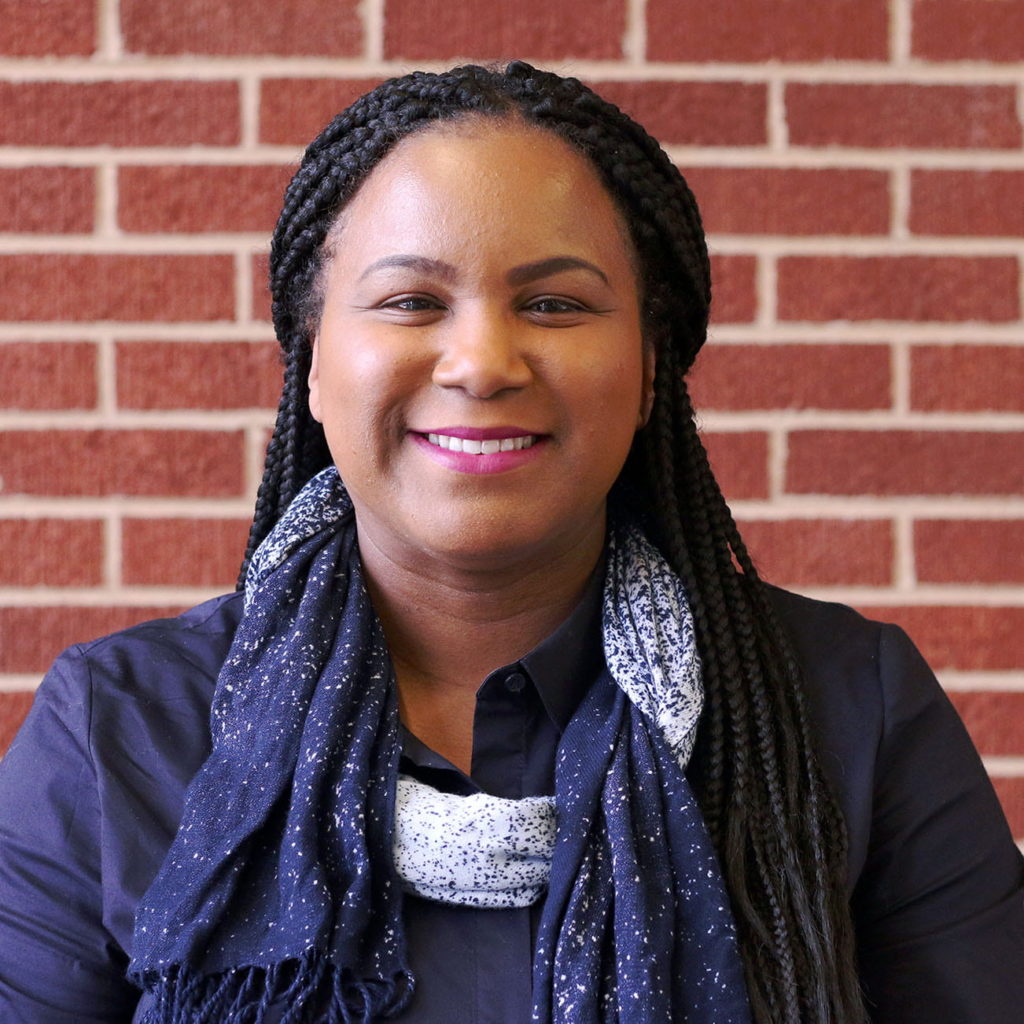
Baylor launched “Champions of Change” awards to recognize and acknowledge the accomplishments of faculty, staff, and alumni (one of each annually) who have demonstrated efforts to “foster greater appreciation and advancement of diversity, inclusiveness, and equity for communities of color at Baylor and in Waco.” A diverse and representative volunteer advisory committee sought nominations and made the final selections for the inaugural honorees.
Scott’s efforts in equity enhancement have included promoting the recruitment and retention of first-generation college students and students of color through advising student organizations; establishing a reputation for being empathetic and supportive of students from traditionally marginalized backgrounds; and focusing her research on multicultural awareness, diversity practices, and urban education and literacy.
“I am humbled by this recognition, and I do not take this honor lightly,” Scott said. “This notion of being a champion of change truly challenges us to continue in our efforts to call into question and/or critique the structural and systemic barriers that limit human flourishing. While I am grateful that my efforts have been noticed, there is still so much to do, especially in thinking about equitable education as a right, not a privilege, for all students in our country. I am thankful to do my part in Waco — the strides made here can provide a national model for evoking true change in education.”
For three years, Scott served as the Chair of the Campus Diversity Committee and currently serves on the President’s Diversity Council. Scott also won Baylor’s Diversity Enhancement Award in 2018 and this year is the recipient of Baylor’s Outstanding Faculty Teaching Award (tenure-track) She is the founding director of Baylor’s Freedom Schools, a summer literacy enrichment program for elementary and middle school youth which focuses on culturally relevant teaching practices and the utilization of multicultural literature in order to bridge summer learning loss.
Teaching in the Department of Curriculum & Instruction and serving as the department’s graduate program director, Scott is a recognized scholar in the field of Urban Education. Her credits include a host of research publications, co-authored and co-edited books, book chapters, and educational evaluation reports.
When the awards were presented at the end of the spring semester, Baylor President Dr. Linda Livingstone said, “The impact of this year’s Champions of Change echoes far beyond the halls of Baylor University, reverberating well into the greater Waco community. Each of these amazing leaders embodies the character and commitment to equity we seek in reflecting Baylor’s Christian mission.”
The impact of Scott’s work has indeed reverberated beyond campus, as she also received recognition from the Greater Waco Chamber of Commerce, receiving their “Waco Under 40” Award honoring “dynamic young leaders under the age of 40” who are making an impact in the greater Waco community.
Scott said, “I believe strongly that through service, love, and intentionality, we can transform our community spaces in ways that translate to human flourishing. I am honored to be among my esteemed peers and colleagues who also consider themselves servants of the greater Waco community.”
The Act Locally Waco blog publishes posts with a connection to these aspirations for Waco. If you are interested in writing for the Act Locally Waco Blog, please email Ferrell Foster at [email protected].
By Jeremy Rhodes
The first wave of data releases from the 2020 US Census is here, and many of the demographic shifts that we’ve seen across the country and the state are mirrored in our Waco community. In this series of posts, I will present some of the demographic changes we see in McLennan County from 2010 to 2020.
The first post presented numbers regarding general population growth and decline. The second post showed an overview of racial and ethnic changes in the county. This post will expand on the racial/ethnic changes in McLennan County since 2010.
I made a series of maps that show us which parts of Waco have experienced growth and decline for some of the major racial and ethnic groups from 2010-2020, using census tract boundaries. For each of these maps, the orange areas showed decline for that group, while the green areas showed increases for that group. The black numbers represent the percentage of the residents in that tract who identify with that racial or ethnic group, according to 2020 census numbers.
As I mentioned in the previous post, the Census Bureau advises caution when comparing the racial and ethnic composition of 2010 to that of 2020. According to their website, “data comparisons between the 2020 Census and 2010 Census race data should be made with caution, taking into account the improvements we have made to the Hispanic origin and race questions and the ways we code what people tell us.”
The first map shows us Waco’s Latino population. Almost the entire map is green, indicating numerical growth in almost every census tract. “Percent Latino” declined in 4 census tracts, but increased everywhere else in the county. Even areas with a relatively small Latino population, such as China Spring, Speegleville, Woodway, and Hewitt, showed increases.
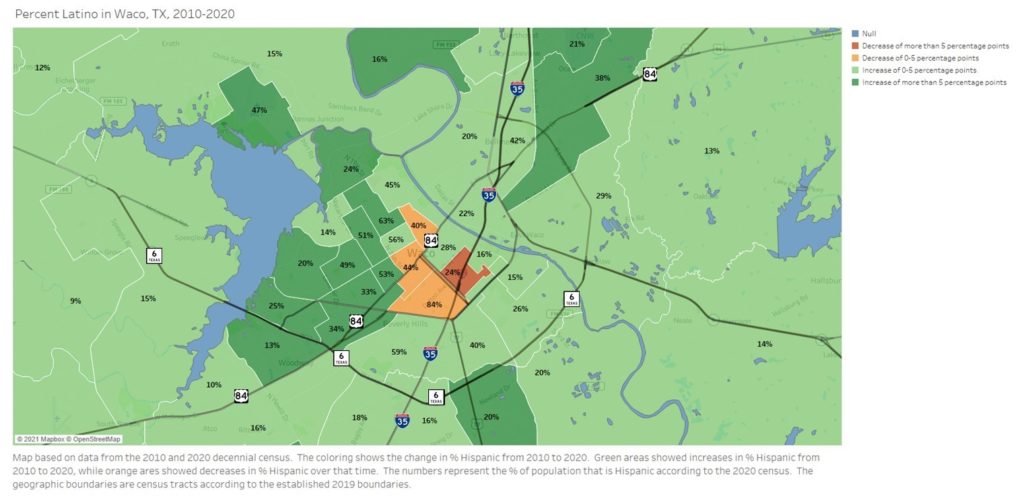
The next map shows Waco’s population who identify as White alone, non-Hispanic. It’s almost the complete opposite of the Hispanic map. Whereas the map of Latinos is almost entirely green, the map of Whites is almost entirely orange. Four census tracts in the interior of Waco show modest increases in percentage of the population that is White, but those are all tracts that already have a low percentage of Whites.
Everywhere else in the county shows declines in percentage of the population that is White. It should be noted that the orange areas do not necessarily represent a decline in the number of White people in that area, just a decline in the percentage of the population that is White. Many of the orange areas on each of these maps have more people in them from those groups, just a lower share of the population. It should also be noted that most of the orange areas on this map are a dark orange, indicating a decline of more than 5 percentage points since 2010.
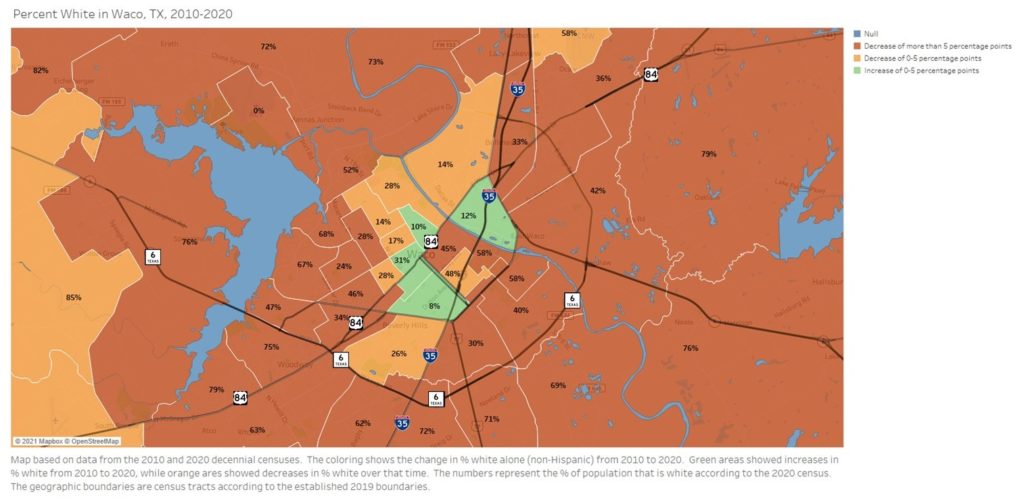
The next map shows the growth and distribution of Black residents in Waco who identify as only Black, non-Hispanic. Unlike the maps for Latinos and Whites, this map shows a mixed story. The tracts are split evenly between those that show growth in percentage Black and those that show decline. East Waco showed a decline in percentage Black, but these areas are still the places in Waco with the highest percentage of African Americans.
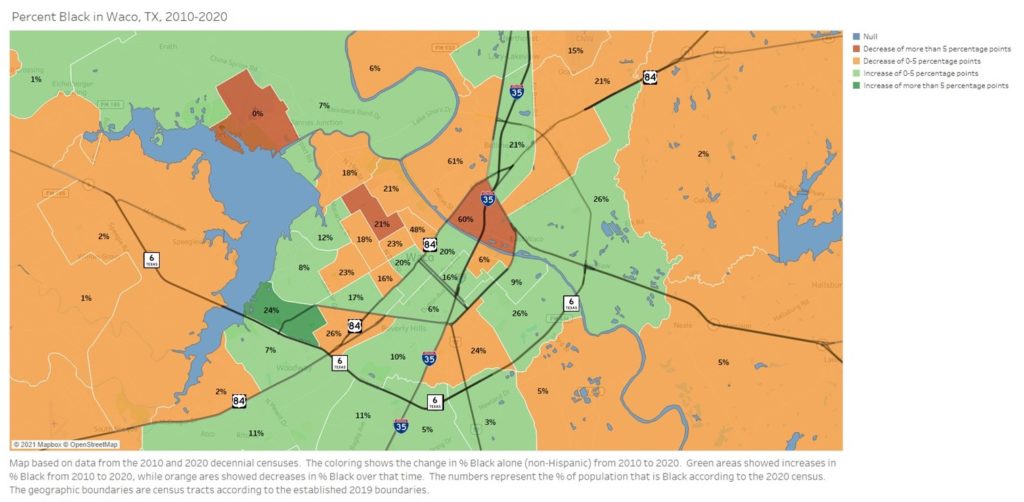
The next map shows the growth and distribution of Asians in Waco, which includes folks who identify with East Asian cultures such as those of China and Korea, Southeast Asian cultures such as those of Vietnam and Indonesia, and South Asian cultures such as those of India and Pakistan. Similar to the story for Latinos, most of Waco has seen an increase in the percentage of residents who identify as Asian. Most of the areas of Central Waco have seen modest increases in percent Asian, though the numbers remain small. In most Waco census tracts, less than 2% of the residents are Asian. The notable exceptions include areas near Baylor University, and the Hewitt/Woodway areas.

The final map shows the percentage of Waco residents who identify with more than one racial identity. All areas have shown growth, and the shade of green shows the amount of growth for that census tract. The areas with the darkest shade of green, mostly within the city limits, have each seen increases of at least 10 percentage points. As I mentioned in the previous post, the increase in multiracial people is caused by 3 reasons.
- Improvements in the census questions allow for a more accurate count
- Reduced stigma for interracial couples has led to more pairings, and more biracial children
- Interracial people are more willing to identify as such than in the past
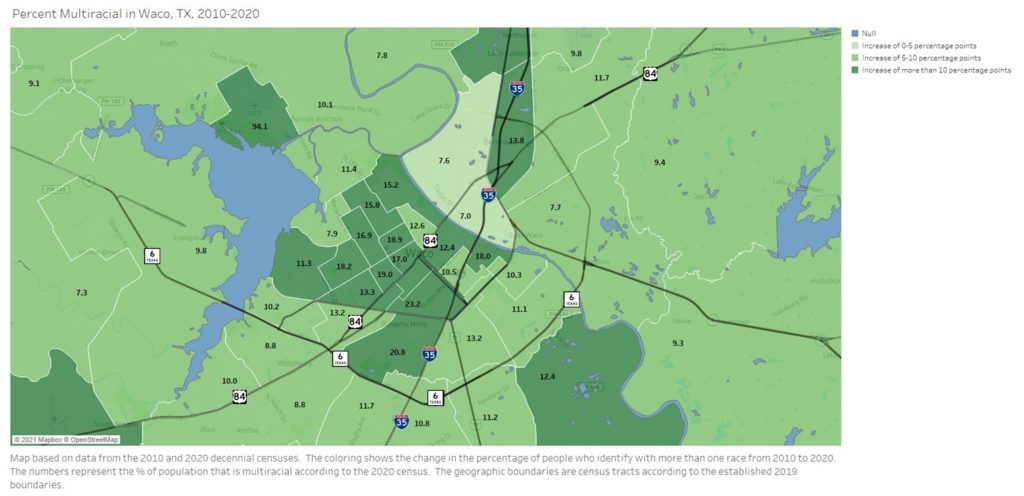
If you have any questions about this, or if you would like Jeremy to give an overview of these changes to your group, staff, or organization through Zoom or in person, please contact Jeremy Rhodes at [email protected].
Jeremy Rhodes, Ph.D., is director of research and community impact for Prosper Waco.
The Act Locally Waco blog publishes posts with a connection to these aspirations for Waco. If you are interested in writing for the Act Locally Waco Blog, please email Ferrell Foster at [email protected].
By Jeremy Rhodes
The first wave of data released from the 2020 US Census is here, and many of the demographic shifts that we’ve seen across the country and the state are mirrored in our Waco community. In this series of posts, I am presenting some of the demographic changes we see in our county from 2010 to 2020. The first post presented numbers regarding general population growth and decline. This second post will show an overview of racial and ethnic changes in the county.
The census website advises caution when comparing the racial and ethnic composition of 2010 to that of 2020. According to their website, “data comparisons between the 2020 Census and 2010 Census race data should be made with caution, taking into account the improvements we have made to the Hispanic origin and race questions and the ways we code what people tell us.”
With that caveat in mind, from 2010 to 2020, the U.S. saw the most dramatic growth among two racial and ethnic groups: Latinos and multiracial people. The U.S. saw a 23% increase in Latinos, while the state of Texas saw a 21% increase in Latinos. In McLennan County, the Latino population increased by 23.6%, or an addition of 13,116 people. Multiracial Americans also saw significant growth throughout much of the United States. In McLennan County, multiracial people now make up 11.8% of the population, which is an increase of 428.6%.
The following table shows a more detailed racial and ethnic makeup for the county, in comparison to Texas and the entire U.S.
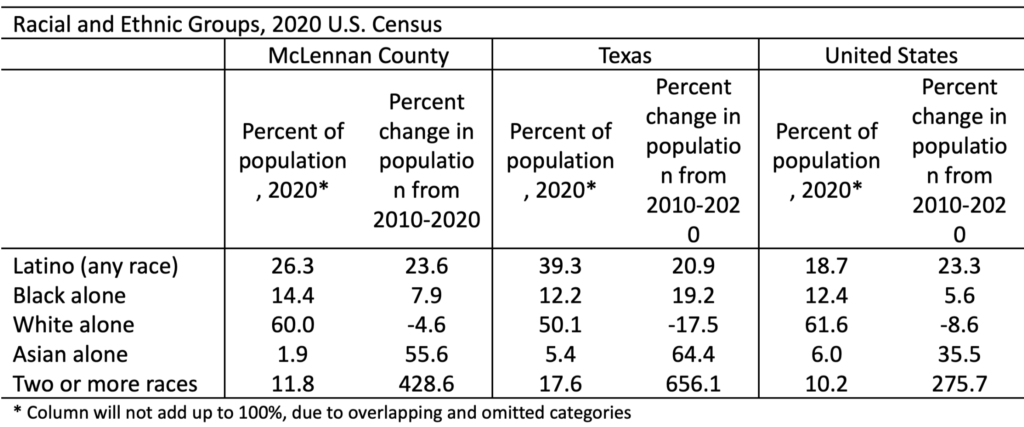
The tremendous growth of multiracial people is caused by multiple factors. The most obvious factor has to do with lessening stigma against interracial relationships. As we come to see more and more interracial pairings, we will have more biracial children being born.
Second, the Census Bureau has improved the way they ask the race/ethnicity question by creating two separate questions for race and ethnicity, which experts believe will provide a more accurate portrait of how people identify (this change is expected to also improve our count of Latinos in America).
Third, there is evidence that multiracial individuals are more willing to identify as such than in the past. For example, a person who has one Black parent and one Latino parent is now less likely to choose between those two identities, and more likely to identify as both.
The next post in this series will display maps that show where we have seen the growth and decline for specific racial/ethnic groups in Waco. If you have any questions about this, or if you would like Jeremy to give an overview of these changes to your group, staff, or organization through Zoom or in person, please contact Jeremy Rhodes at [email protected].

Jeremy Rhodes, Ph.D., is director of research and community impact for Prosper Waco.
The Act Locally Waco blog publishes posts with a connection to these aspirations for Waco. If you are interested in writing for the Act Locally Waco Blog, please email Ferrell Foster at [email protected].




